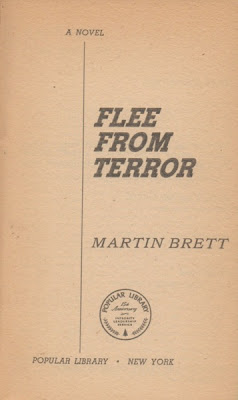Flee from Terror [The Final Run]
Martin Brett [pseud. Douglas Sanderson]
New York: Popular Library, 1957
Bought early last year from a trusted online bookseller, I put off reading this book because of the cover. It wasn't the absurd image on the front – that was kinda fun – but the description on the back:
All that stuff about a master spy, his doublecrossing wife and a daredevil American adventurer, just didn't appeal. The voluptuous mystery woman on the other hand...
I've since discovered that
Flee from Terror features no spy, ergo no spy's wife. The American isn't so much a daredevil or an adventurer as a mindless mule. And that voluptuous mystery woman? Her physical attributes are never described, and you can read her like a book.
Sanderson's hero is John Gregory, a son of Wisconsin – Wausau, I'm guessing – now living in Venice. Once an oilman, he's making a living by running diamonds
in the soles of his shoes to Yugoslavia at three Franklins a trip. The novel opens with Blishen, his employer, offering $10,000 for a final run. At that price, who can resist?
What Blishen doesn't know is that Gregory would've done it for free. Anna, the love of his life – things are still going strong after seven weeks – has asked him to smuggle her brother out of Yugoslavia. Minutes before he's due to leave, Gregory finds the supplier of his smuggling shoes dead in his flat. The American sets out just the same, but I couldn't tell you when. It's here that
Flee from Terror falls apart.
The Final Run, to borrow the UK title, takes place at night. It begins with a drive, Gregory's dumb chauffeur at the wheel, from Venice to Montfalcone (131 km). There the American picks up a mysterious envelope and suffers the frustration of an interrupted tumble with Anna. It's then off to Trieste (30 km) for the second envelop. More mystery ensues when Anna is beaten unconscious by a gang of unknowns. Gregory pays a barkeep to hide his girl, bribes guards at the Yugoslav border (36 km), and makes his way toward Ljubljana (76 km):
The darkness lay around us. It was raining again, and the wipers squeaked jerkily over the windshield. We crawled along the high rock faces, bouncing and jolting, the flints flying up and hitting the under-chasis like pistol shots. We were doing a little under thirty miles an hour [44 km/h]. A stranger would have been lucky to get fifteen.
The chauffeur proves turncoat but remains dumb. Gregory manages an escape in true cartoon style by hanging from a tree limb jutting from the side of a cliff. When he finally reaches Ljubljana our hero finds his contact dead. Gregory is beaten senseless, regains consciousness who knows when, and is rescued by the very same man who had betrayed him just hours before. How many hours? I have no idea.
The reader is now treated to a low-speed sprint to the border, with detour to pick up Anna's brother and some unpleasantness from peasant folk when the dumb chauffeur runs over a goat. It's all trivial stuff when compared to Gregory's trials at the hands of Yugoslavian border guards. The rubber gloves come out.
Amazingly, improbably, our hero manages to get back to Italy. He picks up Anna in Trieste (142 km from Ljubljana), then makes his way back to Venice (159 km).
It's been a long night.
 |
| The Spectator, 21 September 1956 |
Back in the day,
The Spectator gave this novel a bit of a boost, praising the author's talent for torture scenes and Hemingwayesque
staccato. While I know next to nothing about the former, I've long recognized that Sanderson, at his best, can punch on par with Papa. The flaw, the great flaw, in this novel lies in all that running around in the dark. The problem is not the prose, but the plot;
Flee from Terror is not improbable, it's impossible.
Sometimes story gets in the way.
Ribaldry: Seventeen pages in, Gregory runs into Bishen's wife, a former cabaret dancer with whom he had a fleeting fling:
"Hear you lost your gondolier. Overfamiliarity."
For an instant her mouth curled. She hated me. She'd have killed me had there been no laws against it. Then the cabaret came to the fore and she smiled again. She said, "He gave me private poling lessons, darling. He was very good at it. The new one's so grim looking I won't even try."
Object: A 144-page mass market paperback, fifty-five years after publication it's holding up very well. The back cover, about which I've complained too much, features a scene that does not appear in the novel.
Access: The novel first appeared under the author's true name as
The Final Run (London: Secker & Warburg, 1956); only the University of Toronto and Calgary University have copies. No Canadian libraries hold the Popular Library
Flee from Terror edition.
The Secker & Waburg first is scarce. Expect to pay at something close to $50 for something in a decent dust jacket. The print run for the Popular Library would've been massive. Good looking survivors begin at five dollars.
A French translation,
Un bouquet de chardons, was published by Gallimard in 1957. There's not a hit on WorldCat.







































